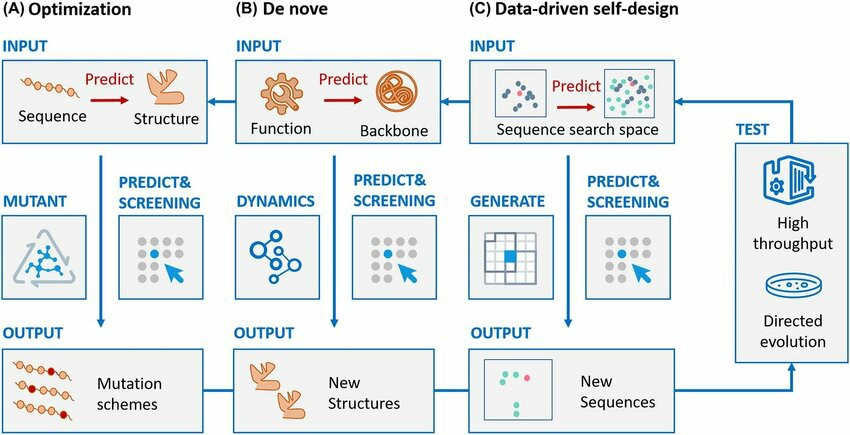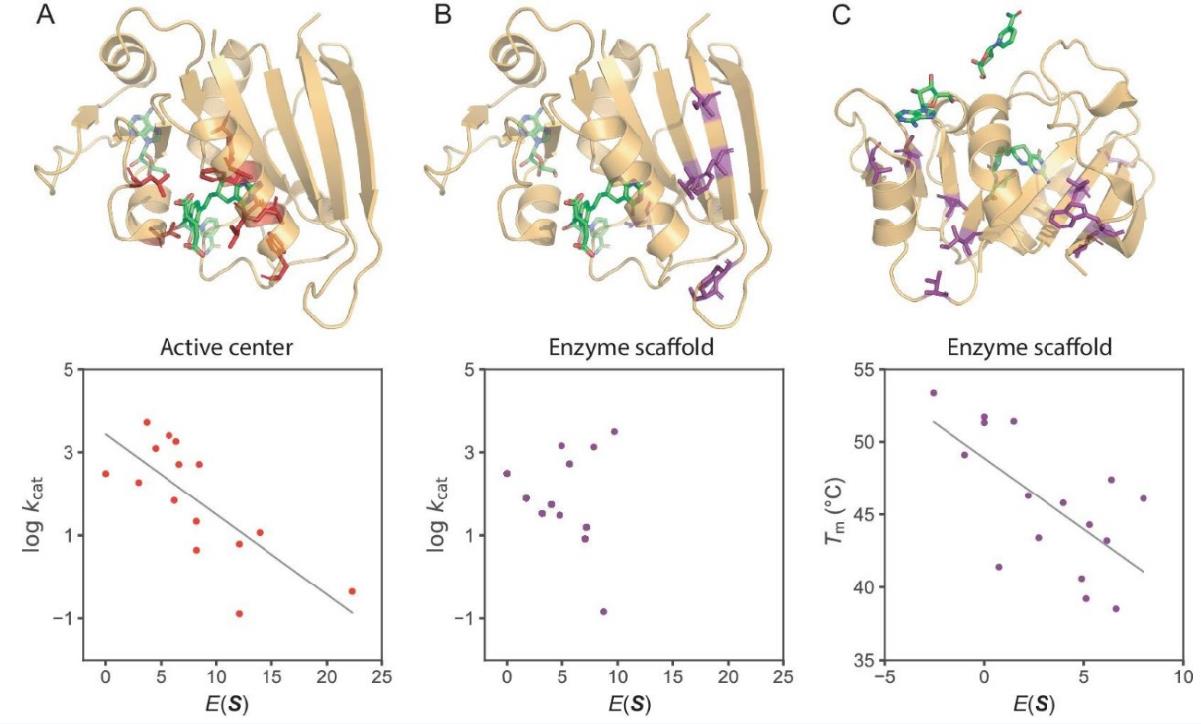AI Guided Enzyme Design is a process that uses artificial intelligence and machine learning to design and improve enzymes. It combines computational methods, machine learning algorithms, and experimental validation for precise results. The use of AI in enzyme design process allows for a more efficient and quicker design of new enzymes, as well as the enhancement of existing ones. It can predict the structure and function of enzymes based on their sequence, removing a lot of the guesswork from enzyme design. It serves a crucial role in modern enzyme design, with the potential to create enzymes with novel functions that could not be achieved using traditional methods.
 Enzyme design strategies and processes by AI (Yongfan Ming, et al., 2022)
Enzyme design strategies and processes by AI (Yongfan Ming, et al., 2022)
Technical Route
The technical route of AI Guided Enzyme Design integrates computational methods, advanced machine learning algorithms, and experimental validation for accurate results. The process starts with the systematic collection of data relating to the enzymes and their specific reactions. This comprehensive data forms the foundation upon which our AI models are trained. Through learning and adaptation, these models excel in designing new enzymes or enhancing the functionalities of existing ones. This process highlights the influence of AI in revolutionizing enzyme design, expanding possibilities and paving the way for exploration and discovery.
Service Process
Our service process is thorough, systematic, and designed to put our customers first. We ensure that every project is handled with the utmost professionalism and attention to detail.
- Initial consultation and project scope definition: Our journey together begins with a comprehensive, in-depth consultation where we aim to understand your specific needs, goals, and expectations. This crucial step enables us to define the scope and direction of the project accurately.
- Data collection: Following the initial consultation, our next step involves the meticulous gathering of extensive, relevant data about the enzymes in question and the specific reactions they catalyze. This process is critical to ensure that we have all the necessary information to craft a precise and effective approach.
- Training of AI models: Leveraging the collected data, we proceed to the essential phase of training our sophisticated AI models. This crucial process ensures that the models are fully equipped, optimized, and ready for the task at hand, allowing them to deliver the best possible results.
- Enzyme design: Once the AI models are thoroughly trained and primed, they are set to the challenging task of designing new enzymes or refining and improving existing ones. This step is where the magic of science and technology truly comes into play.
- Experimental validation: To ensure the reliability, accuracy, and credibility of our work, we carry out a rigorous and thorough experimental validation process. This step gives us confidence in the outcomes and provides a solid foundation for the final product.
- Delivery of designed enzymes: The culmination of our detailed and meticulous process is the delivery of the carefully designed, improved enzymes to you. This final step marks the successful end of our journey, resulting in a product that meets your expectations and helps you achieve your goals.
We're here to assist you. If you have any questions, need more information, or would like to discuss a potential project, please don't hesitate to contact us. Our team is always eager to help and share our expertise.
Applications
| Application |
Description |
Example |
| Pharmaceutical |
AI-guided enzyme design is employed in drug discovery and development, utilizing artificial intelligence to design enzymes tailored to specific therapeutic targets. These enzymes are optimized for improved catalytic activity, substrate specificity, and stability, enhancing the development of novel therapeutic agents. |
Creating enzymes optimized for specific drug metabolism pathways, enhancing drug efficacy and reducing toxicity. |
| Bioremediation |
AI-guided enzyme design aids in environmental remediation by engineering enzymes capable of efficiently degrading contaminants. Through computational modeling and AI algorithms, enzymes are tailored for enhanced activity and specificity, accelerating the degradation of pollutants and promoting ecological restoration. |
Developing enzymes to degrade pollutants like hydrocarbons, facilitating the cleanup of contaminated environments. |
| Industrial Biotechnology |
AI-guided enzyme design optimizes enzymatic processes in industrial biotechnology, utilizing AI algorithms to enhance enzyme efficiency and performance. These engineered enzymes improve productivity and yield in various biotechnological applications, leading to sustainable and cost-effective production processes. |
Designing enzymes for the production of renewable biofuels, increasing yield and reducing production costs. |
Case Study
AI models offer the capability to forecast the effects of mutations on both enzyme activity and stability. The MaxEnt model provides a means to unveil relationships between enzyme properties. For instance, the figure illustrates the correlation observed in dihydrofolate reductase (DHFR). When mutations occur on residues proximal to the substrate or the active center, their sequence probabilities were found to align with enzyme kcat values. In contrast, mutations on the enzyme scaffold, distant from the substrate, exhibited sequence probabilities that aligned more with enzyme thermostability (Tm) than with kcat. (A) The E(S) exhibits a correlation with enzyme activity (kcat) for mutations in the vicinity of the substrate or cofactor, indicated by a Pearson correlation coefficient of −0.74. Mutated sites within the data set are highlighted. (B) The E(S) does not show any correlation with enzyme activity for mutations located on the enzyme scaffold. Mutated sites within the data set are denoted. (C) For mutations occurring on the enzyme scaffold, the E(S) displays a correlation with thermostability (Tm), reflected by a Pearson correlation value of −0.65. Mutated sites are marked in purple.
 Strong correlation between enzyme physicochemical properties and evolutionary information as extracted from sequence data using generative AI, showcased using DHFR. (Wen Jun Xie, et al., 2023)
Strong correlation between enzyme physicochemical properties and evolutionary information as extracted from sequence data using generative AI, showcased using DHFR. (Wen Jun Xie, et al., 2023)
FAQs
In the following section, we will delve into some of the most frequently asked questions and provide comprehensive answers to enhance your understanding of the intricate process of AI Guided Enzyme Design.
Q: Could you explain the purpose of AI Guided Enzyme Design?
A: AI Guided Enzyme Design serves a crucial role in the modern field of enzyme design. The primary purpose is to accelerate and streamline the process of designing enzymes. It leverages the power of artificial intelligence to enable the creation of enzymes with novel functions that could not be achieved using traditional methods.
Q: How does AI contribute to the process of enzyme design?
A: Artificial Intelligence, specifically machine learning models that have been trained with extensive data, can predict the structure and function of enzymes based on their sequence. This capability removes a lot of the guesswork from enzyme design and leads to a more efficient and quicker design process for new enzymes.
Q: Can you name some fields that can benefit from AI Guided Enzyme Design?
A: AI Guided Enzyme Design has a wide range of applications and can contribute significantly to various fields. This includes but is not limited to biotechnology, pharmaceuticals, agriculture, and biofuels. The potential of AI in these fields is vast and still being explored.
Q: How reliable are the results obtained from AI Guided Enzyme Design?
A: The artificial intelligence models used for enzyme design are trained with extensive and well-curated data. Each prediction is also validated through rigorous experimental procedures, ensuring the reliability of the results. However, as with all scientific processes, results should be further validated in the specific context of use.
Q: Could you describe the process of AI Guided Enzyme Design?
A: The process of AI Guided Enzyme Design is comprehensive and involves several stages. It starts with an initial consultation to understand the needs of the project. This is followed by data collection, which forms the basis for training the AI models. The next step is the actual design of the enzymes, which is carried out by the AI models. The designed enzymes then undergo experimental validation to ensure their functionality. The final step is the delivery of designed enzymes to the client.
Q: Is it possible to use AI Guided Enzyme Design to improve existing enzymes?
A: Absolutely, our AI models are not only capable of designing new enzymes but can also be used to enhance the functionalities of existing enzymes. This can be particularly useful in cases where an existing enzyme has known limitations that need to be overcome.
Q: What are some of the advantages of implementing AI in enzyme design?
A: The use of AI in enzyme design offers numerous benefits. It allows for a faster and more efficient design process. Additionally, AI has the potential to create enzymes with novel functionalities that were previously considered unattainable. This opens up new avenues in enzyme design and can potentially revolutionize the field.
Q: Can the process of AI Guided Enzyme Design be customized to cater to specific needs?
A: Yes, we understand that each project has its unique requirements. Therefore, we can customize our process according to the specific needs of a project. This ensures that our clients receive the most suitable and effective solutions for their projects.
Q: How can I initiate the process of AI Guided Enzyme Design?
A: If you are interested in making use of AI Guided Enzyme Design for your project, the process is quite simple. You can get started by reaching out to us for an initial consultation. In this consultation, we will discuss your project, understand its scope, and identify how our services can best meet your needs.

































 Enzyme design strategies and processes by AI (Yongfan Ming, et al., 2022)
Enzyme design strategies and processes by AI (Yongfan Ming, et al., 2022) Strong correlation between enzyme physicochemical properties and evolutionary information as extracted from sequence data using generative AI, showcased using DHFR. (Wen Jun Xie, et al., 2023)
Strong correlation between enzyme physicochemical properties and evolutionary information as extracted from sequence data using generative AI, showcased using DHFR. (Wen Jun Xie, et al., 2023)